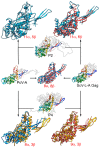Capsid Structure of dsRNA Fungal Viruses
- PMID: 30205532
- PMCID: PMC6164181
- DOI: 10.3390/v10090481
Capsid Structure of dsRNA Fungal Viruses
Abstract
Most fungal, double-stranded (ds) RNA viruses lack an extracellular life cycle stage and are transmitted by cytoplasmic interchange. dsRNA mycovirus capsids are based on a 120-subunit T = 1 capsid, with a dimer as the asymmetric unit. These capsids, which remain structurally undisturbed throughout the viral cycle, nevertheless, are dynamic particles involved in the organization of the viral genome and the viral polymerase necessary for RNA synthesis. The atomic structure of the T = 1 capsids of four mycoviruses was resolved: the L-A virus of Saccharomyces cerevisiae (ScV-L-A), Penicillium chrysogenum virus (PcV), Penicillium stoloniferum virus F (PsV-F), and Rosellinia necatrix quadrivirus 1 (RnQV1). These capsids show structural variations of the same framework, with 60 asymmetric or symmetric homodimers for ScV-L-A and PsV-F, respectively, monomers with a duplicated similar domain for PcV, and heterodimers of two different proteins for RnQV1. Mycovirus capsid proteins (CP) share a conserved α-helical domain, although the latter may carry different peptides inserted at preferential hotspots. Insertions in the CP outer surface are likely associated with enzymatic activities. Within the capsid, fungal dsRNA viruses show a low degree of genome compaction compared to reoviruses, and contain one to two copies of the RNA-polymerase complex per virion.
Keywords: PcV; PsV-F; RnQV1; ScV-L-A; capsid protein; capsid structure; dsRNA virus; mycovirus; viral lineage; virus evolution.
Conflict of interest statement
The authors declare no conflict of interest.
Figures







Similar articles
-
Structure and assembly of double-stranded RNA mycoviruses.Adv Virus Res. 2020;108:213-247. doi: 10.1016/bs.aivir.2020.08.001. Epub 2020 Sep 16. Adv Virus Res. 2020. PMID: 33837717
-
Heterodimers as the Structural Unit of the T=1 Capsid of the Fungal Double-Stranded RNA Rosellinia necatrix Quadrivirus 1.J Virol. 2016 Nov 28;90(24):11220-11230. doi: 10.1128/JVI.01013-16. Print 2016 Dec 15. J Virol. 2016. PMID: 27707923 Free PMC article.
-
Acquisition of functions on the outer capsid surface during evolution of double-stranded RNA fungal viruses.PLoS Pathog. 2017 Dec 8;13(12):e1006755. doi: 10.1371/journal.ppat.1006755. eCollection 2017 Dec. PLoS Pathog. 2017. PMID: 29220409 Free PMC article.
-
Chrysovirus structure: repeated helical core as evidence of gene duplication.Adv Virus Res. 2013;86:87-108. doi: 10.1016/B978-0-12-394315-6.00004-0. Adv Virus Res. 2013. PMID: 23498904 Review.
-
A neo-virus lifestyle exhibited by a (+)ssRNA virus hosted in an unrelated dsRNA virus: Taxonomic and evolutionary considerations.Virus Res. 2018 Jan 15;244:75-83. doi: 10.1016/j.virusres.2017.11.006. Epub 2017 Nov 6. Virus Res. 2018. PMID: 29122644 Review.
Cited by
-
Cryo-electron Microscopy Structure, Assembly, and Mechanics Show Morphogenesis and Evolution of Human Picobirnavirus.J Virol. 2020 Nov 23;94(24):e01542-20. doi: 10.1128/JVI.01542-20. Print 2020 Nov 23. J Virol. 2020. PMID: 32938763 Free PMC article.
-
Identification, Molecular Characterization, and Biology of a Novel Quadrivirus Infecting the Phytopathogenic Fungus Leptosphaeria biglobosa.Viruses. 2018 Dec 25;11(1):9. doi: 10.3390/v11010009. Viruses. 2018. PMID: 30585188 Free PMC article.
-
Capsid Structure of Leishmania RNA Virus 1.J Virol. 2021 Jan 13;95(3):e01957-20. doi: 10.1128/JVI.01957-20. Print 2021 Jan 13. J Virol. 2021. PMID: 33208443 Free PMC article.
-
Double-stranded RNA sequencing reveals distinct riboviruses associated with thermoacidophilic bacteria from hot springs in Japan.Nat Microbiol. 2024 Feb;9(2):514-523. doi: 10.1038/s41564-023-01579-5. Epub 2024 Jan 17. Nat Microbiol. 2024. PMID: 38233646 Free PMC article.
-
Structure Unveils Relationships between RNA Virus Polymerases.Viruses. 2021 Feb 17;13(2):313. doi: 10.3390/v13020313. Viruses. 2021. PMID: 33671332 Free PMC article.
References
-
- Patton J.T. Segmented double-stranded RNA viruses. Structure and Molecular Biology. Caister Academic Press; Norfolk, UK: 2008.
-
- Hill C.L., Booth T.F., Prasad B.V., Grimes J.M., Mertens P.P., Sutton G.C., Stuart D.I. The structure of a cypovirus and the functional organization of dsRNA viruses. Nat. Struct. Biol. 1999;6:565–568. - PubMed
Publication types
MeSH terms
Substances
Grants and funding
LinkOut - more resources
Full Text Sources
Other Literature Sources
Molecular Biology Databases
Miscellaneous

